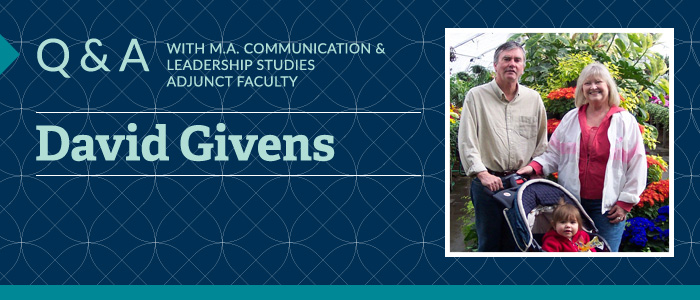The faculty in the M.A. in Communication & Leadership Studies program are leaders in the field of communication. Their contributions advance the way communication is understood, taught, and used in a rapidly changing world. Our award-winning faculty are at the top of their field and their areas of expertise span the spectrum of communication disciplines.
In the Jesuit tradition of cura personalis, the COML faculty are committed to the intellectual development and success of students both in and outside of the classroom. More than imparting knowledge for knowledge’s sake, our faculty embrace the Ignatian mission to impart knowledge for the sake of the betterment of community.
DAVID GIVENS
Biography
David B. Givens began studying “body language” for his Ph.D. in anthropology at the University of Washington in Seattle. He served as Anthropologist in Residence at the American Anthropological Association in Washington, D.C. from 1985-97, and is currently Director of the Center for Nonverbal Studies in Spokane, Washington. He taught anthropology at the University of Washington and teaches in the School of Professional Studies at Gonzaga University. His expertise is in nonverbal communication, anthropology, and the brain. Givens offers seminars to lawyers, judges, social workers, salespeople, and physicians; works with local law-enforcement agencies and the FBI; and consults with the U.S. intelligence community. Givens’s scholarly articles are recognized as international classics by the Max Planck Institute in Germany. Givens and neuroscientist Paul D. MacLean introduced the word “isopraxism” (the reptilian principle of mimicking) into the English language, as announced by the executive editor of the American Heritage Dictionary in the Atlantic Monthly. Givens was a member of a team of anthropologists, linguists, astronomers, and nuclear physicists charged by the U.S. Dept. of Energy with designing a marker to warn human beings 10,000 years in the future about the dangers of nuclear waste. Givens has spoken to the Smithsonian Institution, National Academy of Sciences, European COLIPA, U.S. EPA, Washington State Administrator for the Courts, and other groups. He has done consulting for Sandia National Laboratories, the Bechtel Group, U.S. Department of Energy, Pfizer, Epson, Wendy’s International, Dell Inc., Unilever, Hallmark, Masterfoods USA, Kimberly Clark, and Best Buy. His ideas on nonverbal communication have been written about in Omni, Harpers, the New Yorker, U.S. News & World Report and in the New York Times, Washington Post, and Los Angeles Times. Givens is the author of Love Signals: A Practical Field Guide to the Body Language of Courtship (St. Martin’s, New York, 2005), Crime Signals: How to Spot a Criminal Before You Become a Victim (St. Martin’s, 2008), and Your Body at Work: A Guide to Sight-reading the Body Language of Business, Bosses, and Boardrooms (St. Martin’s, 2010). His online Nonverbal Dictionary is used around the world as a reference tool.
Q & A with Dr. David Givens
Q: How long have you been teaching for the COML program?
A: Six years
Q: What is the project/publication/professional accomplishment you are most proud of?
A: I’m most proud of my online Nonverbal Dictionary. I’m constantly revising and adding to it. It has connected me to readers around the world.
“A masterful piece of work” –American Library Association
“Highly recommended” —New Scientist
“Its contents will enlighten you.” —Discover magazine’s “Pick of the Web”
“Monumental” –Yahoo! Picks of the Week
Q: What project are you currently working on?
A: I’m researching neurological links between hand gestures and speech. In 2013, a neural connection between gestural (pectoral) and vocal (laryngeal) communication was found. I’m also exploring the role mirror neurons play in decoding our nonverbal signs, signals, and cues.
Q: What area in the discipline of communication are you most passionate about/is your expertise in?
A: I’m close to publishing an article to reveal the origin of human language. So, in other words, I dream on . . .
Q: What things we should be thinking about in the field of communication? Notable trends?
A: The most exciting communication research today focuses on how the human brain encodes and decodes verbal and nonverbal messages. Mirror neurons are especially hot right now.
Q: How does the COML program/GU differ from other programs/schools that you teach for?
A: When I taught at the University of Washington, it was knowledge for knowledge’s sake. At Gonzaga, it’s knowledge for the sake of improving lives. I like both approaches, but especially the latter, which is Ignatian in scope and perspective.
Q: What book are you reading right now?
A: They Came to Baghdad, by Agatha Christie–for a feeling of the city before Saddam Hussein.
